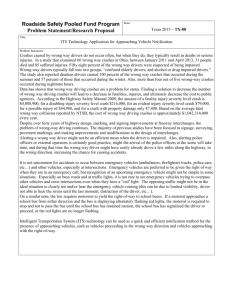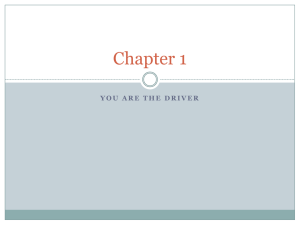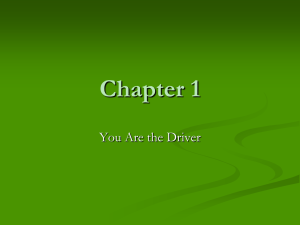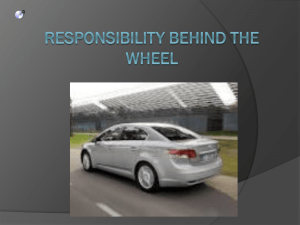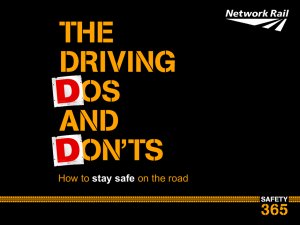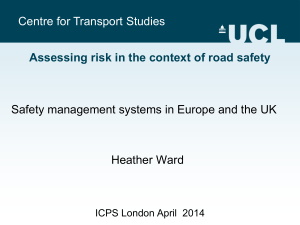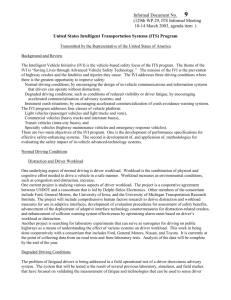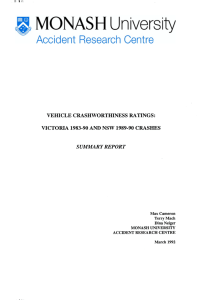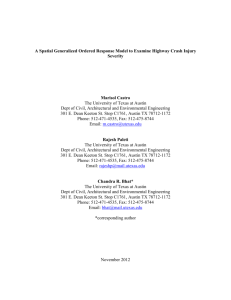Drivers Education
advertisement
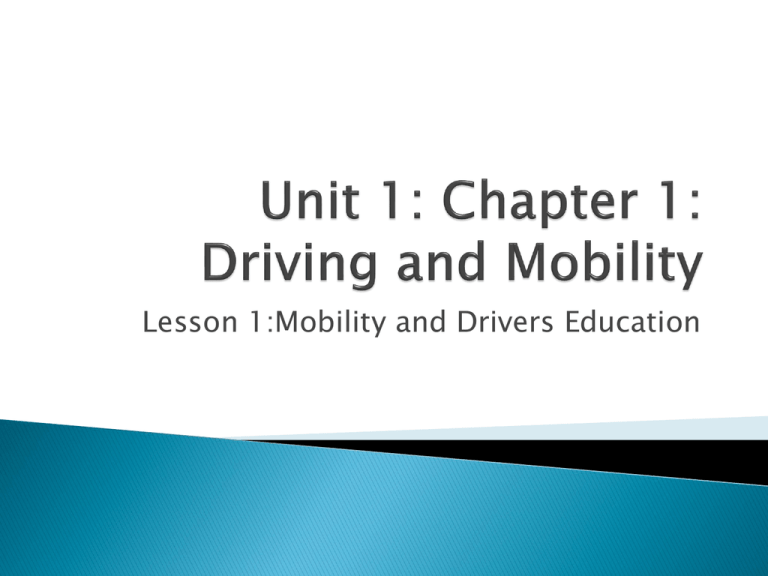
Lesson 1:Mobility and Drivers Education Physical, Mental, and Social Driving Mobility Crash Take out a piece of paper: In a group of 4 Come up with 10 items that make you a good driver. (10 minutes-Read Out) By yourself: 1. What do you hope to gain from this class. 2. What experiences do you have as a passenger in a vehicle? 3. How do you think Highway driving is different from on local roadways. 4. What risks do you think you will face each time you drive a car or other vehicle. Physical: Pressing the gas pedal, using the steering wheel, using eyes, turn signal.. Mental: drivers must make sound judgments and decisions based on an intelligent assessment of the traffic situations. Social: its social because drivers share the roadway with other drivers and with pedestrians. What if you only focus on 1 or 2 Tasks? There are now more than 230 million registered vehicles in the United states The United states has more than 190 million licensed drivers. Every year, more than 6.3 million policereported collisions occur in the united states. Crashes result in about 43,000 fatalities and nearly 2.9 million disabling injuries in the United states each year. Will Provide you an opportunity to learn much of the information and skills you need to be a good driver. ◦ To be alert, knowledgeable and a skillful driver that is capable of handling a wide range of driving situations. Useful Knowledge Managing visibility, Time, and Space Awareness of Limiting Factors Can help you understand: ◦ How your personality , emotions and maturity affect your driving. ◦ How to maneuver and control your vehicle to minimize risks in different driving environments. ◦ How alcohol and other drugs impair your ability to drive, and knowledge of the penalties for their use. ◦ What other useful knowledge do we need to know? Drivers education will increase your awareness of the roadway and its surroundings. You will learn to Learn how to better manage visibility, time and space. Factors that can interfere with your ability to drive safely include: ◦ The foolish feeling that there is little or no risk involved in driving and hat if a collision occurs, it’s “the other persons fault” ◦ An illness or injury that you have, or the side effects of the medicine you be taking. ◦ Your emotional state at the time of your driving You gain knowledge of the rules of the road through drivers education. EXPERIENCE will sharpen your decision-making abilities. How does being in charge of your own mobility affect both your actions and your attitudes. What special concerns do you think parents and guardians may have when teens begin to drive? When it comes to driving safely, younger drivers have a lot to learn since they are involved in more crashes that other drivers. When a motor Vehicle hits another vehicle, a pedestrian, an animal, a bicyclist or a fixed object, this is called a CRASH. ◦ Teen Crashes Talk (graduated license handout (prevention) and reduction) Lacking EXPERIENCE Driving at Dangerous Times TRANSPORTING PASSENGERS. driving differently. Frequent Crashes due to lack of driving experience Best way to overcome this obstacle is to practice driving as much as possible in different situations and driving environments. More driving = more experience One good way to overcome this obstacle is to observe an experienced driver and watch how they handle various situations when they are driving. Driving at night is more dangerous than driving during the day. Probability of crashing increases with each passenger riding with a young driver. What do you think some reasons young drivers are over-represented in crashes? (pg.8) Young drivers tend to speed and not pay attention to their driving more often than older drivers. Less likely to use protective devices such as: ◦ Safety Belts 3 Simple Steps to avoid over-representation: ◦ Travel at the safest speed limit (posted speed limit is not always the safest-think environment) ◦ Make driving a focus of your attention ◦ ALWAYS use protective devices when you are in your vehicle List 3 skills or abilities you will gain from drivers education. What are some factors that might affect your ability to drive safely. What factors cause young drivers to be overrepresented in crash statistics. Lesson 2: The Highway Transportation System Highway Transportation System (HTS) Collision Discussion: What roads will you drive most on? Narrow Mt Roads Wide Boulevards Twisting country roads Crowded City Streets Busy high ways 2 Lane country 4 Lane city Motor Vehicles, Streets and highways, and people/bicyclists are the components of the Highway Transportation System. Some roadways are smooth and well maintained, while others are riddled with cracks, bumps and potholes. The different roads in the HTS can be a challenge, especially at night or in poor weather. FYI on highways( N-S (55)) Cars very in how difficult they are to handle and drive. EX: A heavy truck does not accelerate, steer or brake the same way that a light weight sports car does. What types of vehicles do we see on the HTS? Motor vehicles vary too, in safety features an in their ability to provide protection to drivers and passengers in case of a collision, or crash. ◦ Explain vehicle differences ◦ Discuss safety features As a driver you must be able to anticipate and learn to cope with unsafe practices: ◦ Reckless drivers, people crossing streets without looking or motorcyclists weave their bikes through traffic. Tips for new drivers Federal, state and local governments work together to regulate the HTS. Law enforcement enforces speed. (55-1974, changed to allow own speed limits in per state in 1995) EX: implementing a speed limit. What is our Highway Speed limit-is this safe? Even # highway runs N-S (55) Odd # Highway runs E-W (74) (474) The national traffic and motor control act requires automakers to build certain safety features into their vehicles, such as safety belts and shatterproof windows. In 38 states-teens under a certain ageusually 17-18 are not allowed to drive at night. Drivers may turn right on red except where areas are prohibited. What would you do Picture. What are the three points of the HTS Who regulates the HTS. Give examples. What is the significance of the way the high ways are numbered. Lesson 3: The risks of driving. Risk Visibility Time Space Risk is the possibility of person injury or damage to vehicles and property. First thing as a new driver you need to understand is that risks are real-and happen more often than we think. Facts: ◦ Read from the book pg. 13 Many Factors contribute to the risk of driving: ◦ Bad Weather Driving responsibly=assessing your risks and doing what you can do reduce them. 5 Ways to reduce or control risk: Keep your vehicle in top condition Anticipate the actions of others Protect yourself and others Drive only when you’re in sound physical and mental condition ◦ Make a conscious effort to develop your driving skills ◦ ◦ ◦ ◦ Searching and giving meaning Understanding options and choices Mastering basic driving skills. ◦ These will all come with experience Visibility: Refers to what you can see from behind the wheel and how well you can see it. Time: Involves the ability to judge your speed and the speed of other vehicles and highway users. Space: Refers to distance. As a driver you must keep a margarine of space between you and other vehicles. Look at the picture on pg. 15 What factors are contributing to risk? What steps can you take to reduce risk? What are the 5 ways that you can reduce or control risk when driving? Describe visibility, time and space as they relate to driving? What factors may contribute to driving risk? Lesson 4: The costs of driving Cost Cost-benefit Costs: measured in dollars and lives. Operating Costs: ◦ Gas, Oil, maintance and tires ◦ More miles you drive=greater operating costs Fixed Costs ◦ Car insurance and licensing fees ◦ More miles you drive=smaller fixed costs per mile. ◦ Read Dr. John W Palmer Use protective devices such as seat belts, child restraints or motorcycle helmets, avoid mixing alcohol use and driving; and maintain appropriate speeds. Reduces risks Cost-benefit ratio: The way you weigh the benefits you receive from driving versus what driving a vehicle actually costs. Picture: What would you do? ◦ Who is affected, what are the costs? List some of the crash costs of driving Describe 3 non crash costs of driving How can you minimize crash costs of driving. Chapter 1 Assessment Study for ROR 1-4 quiz(study Guide) Read Chapter 3

